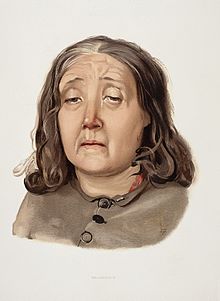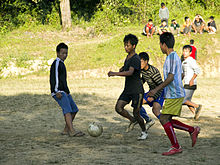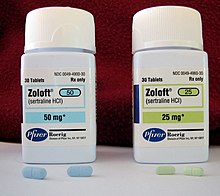Major depressive disorder
[5] Risk factors include a family history of the condition, major life changes, childhood traumas, environmental lead exposure,[16] certain medications, chronic health problems, and substance use disorders.[1][5] A person having a major depressive episode usually exhibits a low mood, which pervades all aspects of life, and an inability to experience pleasure in previously enjoyable activities.[18] Other symptoms of depression include poor concentration and memory,[19] withdrawal from social situations and activities, reduced sex drive, irritability, and thoughts of death or suicide.[40] American psychiatrist Aaron Beck suggested that a triad of automatic and spontaneous negative thoughts about the self, the world or environment, and the future may lead to other depressive signs and symptoms.[43] Family and twin studies find that nearly 40% of individual differences in risk for major depressive disorder can be explained by genetic factors.[71] One proposed explanation for the therapeutic lag, and further support for the deficiency of monoamines, is a desensitization of self-inhibition in raphe nuclei by the increased serotonin mediated by antidepressants.[26] Episodes may be isolated or recurrent and are categorized as mild (few symptoms in excess of minimum criteria), moderate, or severe (marked impact on social or occupational functioning).[130][135][136] Because such interventions appear to be most effective when delivered to individuals or small groups, it has been suggested that they may be able to reach their large target audience most efficiently through the Internet.[143] The UK National Institute for Health and Care Excellence (NICE) 2004 guidelines indicate that antidepressants should not be used for the initial treatment of mild depression because the risk-benefit ratio is poor.[149] Talking therapy (psychotherapy) can be delivered to individuals, groups, or families by mental health professionals, including psychotherapists, psychiatrists, psychologists, clinical social workers, counselors, and psychiatric nurses.The most-studied form of psychotherapy for depression is CBT, which teaches clients to challenge self-defeating, but enduring ways of thinking (cognitions) and change counter-productive behaviors.[160][161] Cognitive behavioral therapy and occupational programs (including modification of work activities and assistance) have been shown to be effective in reducing sick days taken by workers with depression.[171] In a meta-analysis of three controlled trials of Short Psychodynamic Supportive Psychotherapy, this modification was found to be as effective as medication for mild to moderate depression.[174] Similarly, a Cochrane systematic review of clinical trials of the generic tricyclic antidepressant amitriptyline concluded that there is strong evidence that its efficacy is superior to placebo.[205] A black box warning was introduced in the United States in 2007 on SSRIs and other antidepressant medications due to the increased risk of suicide in people younger than 24 years old.[210][211] A nasal spray form of esketamine was approved by the FDA in March 2019 for use in treatment-resistant depression when combined with an oral antidepressant; risk of substance use disorder and concerns about its safety, serious adverse effects, tolerability, effect on suicidality, lack of information about dosage, whether the studies on it adequately represent broad populations, and escalating use of the product have been raised by an international panel of experts.[102] Lithium appears effective at lowering the risk of suicide in those with bipolar disorder and unipolar depression to nearly the same levels as the general population.[219] Low-dose thyroid hormone may be added to existing antidepressants to treat persistent depression symptoms in people who have tried multiple courses of medication.[237] The American Psychiatric Association,[238] the Canadian Network for Mood and Anxiety Disorders,[239] and the Royal Australia and New Zealand College of Psychiatrists have endorsed TMS for trMDD.Outpatients on a waiting list show a 10–15% reduction in symptoms within a few months, with approximately 20% no longer meeting the full criteria for a depressive disorder.Additional psychological interventions (such as online cognitive behavioral therapy) lead to fewer sick days compared to standard management only.[278][279] Depressive disorders are more common in urban populations than in rural ones and the prevalence is increased in groups with poorer socioeconomic factors, e.g., homelessness.[294] The Ancient Greek physician Hippocrates described a syndrome of melancholia (μελαγχολία, melankholía) as a distinct disease with particular mental and physical symptoms; he characterized all "fears and despondencies, if they last a long time" as being symptomatic of the ailment.[295] It was a similar but far broader concept than today's depression; prominence was given to a clustering of the symptoms of sadness, dejection, and despondency, and often fear, anger, delusions and obsessions were included.[296] Adolf Meyer put forward a mixed social and biological framework emphasizing reactions in the context of an individual's life, and argued that the term depression should be used instead of melancholia.Nevertheless, analysis or interpretation of letters, journals, artwork, writings, or statements of family and friends of some historical personalities has led to the presumption that they may have had some form of depression.People who may have had depression include English author Mary Shelley,[316] American-British writer Henry James,[317] and American president Abraham Lincoln.[318] Some well-known contemporary people with possible depression include Canadian songwriter Leonard Cohen[319] and American playwright and novelist Tennessee Williams."[327][328] English writer Samuel Johnson used the term "the black dog" in the 1780s to describe his own depression,[329][330] and it was subsequently popularized by British Prime Minister Sir Winston Churchill, who also had the disorder.[329][330] Johann Wolfgang von Goethe in his Faust, Part One, published in 1808, has Mephistopheles assume the form of a black dog, specifically a poodle.





no data
<700
700–775
775–850
850–925
925–1,000
1,000–1,075
1,075–1,150
1,150–1,225
1,225–1,300
1,300–1,375
1,375–1,450
>1,450



mood disorderdepression (mood)Sorrowing Old Man (At Eternity's Gate)Vincent van GoghSpecialtyPsychiatryclinical psychologySymptomsLow moodself-esteemloss of interestlow energyinsomniahypersomniaComplicationsSelf-harmsuicideadverse life experiencesgenetic predispositionstressRisk factorsFamily historymedicationschronic health problemssubstance use disorderDifferential diagnosisBipolar disordersadnessPsychotherapyantidepressant medicationelectroconvulsive therapytranscranial magnetic stimulationexerciseMedicationAntidepressantsmental disorderloss of interest or pleasureAmerican Psychiatric Associationsymptom clustermood disordersDiagnostic and Statistical Manual of Mental Disordersyears lived with disabilitylower back painmental status examinationmajor depressive episodesinvoluntaryself-neglectgeneticlead exposuresubstance use disorderslithographmelancholiamajor depressive episoderuminatesex drivediurnal mood variationpsychoticdelusionshallucinationsfatigueWorld Health OrganizationAppetitepersonal relationshipsagitationlethargyBiology of depressionEpigenetics of depressiondiathesis–stress modelbiopsychosocial modeldiathesisnature and nurtureschematicAaron Beckworld or environmentFamily and twin studiesexplained by genetic factorsgenome-wide association studyHIV/AIDSasthmabasal gangliaParkinson's diseaseiatrogenicinterferonsbeta-blockersisotretinoincontraceptivesanticonvulsantsantimigraine drugsantipsychoticshormonal agentsgonadotropin-releasing hormone agonistCeliac diseasepostpartum depressionpregnancySeasonal affective disorderAdverse childhood experienceschildhood abusefamily dysfunctionair pollutionmonoaminergiccircadian rhythmHPA-axismonoamine neurotransmitterstryptophanserotonin5-HTTLPRlocus coeruleustyrosine hydroxylasealpha-2 adrenergic receptoradrenergichomovanillic aciddextroamphetaminedopamine receptordopamine receptor D1striatumpolymorphismdopaminemonoamine oxidaseraphe nuclei5-HIAAselective serotonin reuptake inhibitorcarbohydratesdexamethasone testmeta-analysiscortisol awakening responseGut-Brain axis